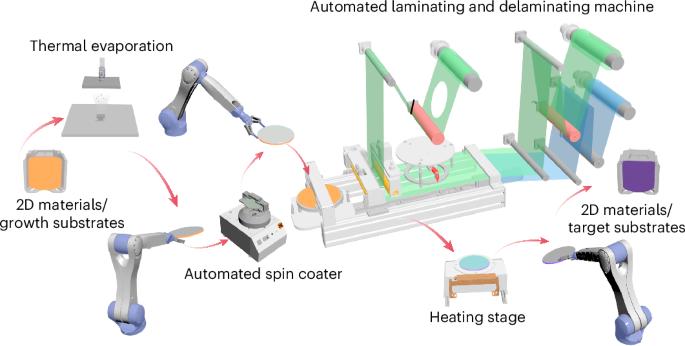Automated processing and transfer of two-dimensional materials with robotics
引用次数: 0
Abstract
Chemical vapor deposition (CVD) has enabled two-dimensional (2D) materials and their heterostructures to become promising material platforms for next-generation electronics and photonic devices. However, the robust processing of 2D materials produced by CVD is currently hindered by the lack of a scalable and reliable technique to transfer materials from their growth substrates to target substrates for end applications. Here we introduced an automated system to enable the transfer of CVD-grown 2D materials with robotics by engineering the interfacial adhesion and strain. The developed automated transfer system shows industrial compatibility, as demonstrated by the high production capability (up to 180 wafers per day), reliable transfer quality (with transferred graphene carrier mobilities over 14,000 cm2 V−1 s−1), and high uniformity and repeatability of the transferred materials. The developed system also outperforms conventional manual transfer methods in terms of minimizing cost and environmental impact. This automated system could accelerate the research and commercialization of 2D materials in the future. Robust, high-throughput processing of two-dimensional materials produced by chemical vapor deposition requires a reliable and scalable technique to transfer the materials to a target substrate. An automated system for transferring chemical-vapor-deposited two-dimensional materials using robotics is developed, demonstrating high production capability with uniformity and repeatability of the transferred materials.

用机器人技术自动处理和转移二维材料
化学气相沉积(CVD)使二维(2D)材料及其异质结构成为下一代电子和光子器件的有前途的材料平台。然而,由于缺乏一种可扩展和可靠的技术来将材料从生长基板转移到最终应用的目标基板上,CVD生产的二维材料的稳健加工目前受到阻碍。在这里,我们介绍了一个自动化系统,通过设计界面粘附和应变,利用机器人技术实现cvd生长的2D材料的转移。开发的自动化转移系统具有工业兼容性,如高生产能力(每天高达180片晶圆),可靠的转移质量(转移的石墨烯载流子迁移率超过14,000 cm2 V−1 s−1)以及转移材料的高均匀性和可重复性。开发的系统在成本和环境影响最小化方面也优于传统的人工转移方法。这种自动化系统可以加速未来二维材料的研究和商业化。通过化学气相沉积产生的二维材料的稳健,高通量处理需要可靠且可扩展的技术将材料转移到目标基板上。开发了一种利用机器人技术转移化学气相沉积二维材料的自动化系统,该系统具有高的生产能力,具有转移材料的均匀性和可重复性。
本文章由计算机程序翻译,如有差异,请以英文原文为准。
求助全文
约1分钟内获得全文
求助全文

 求助内容:
求助内容: 应助结果提醒方式:
应助结果提醒方式:


